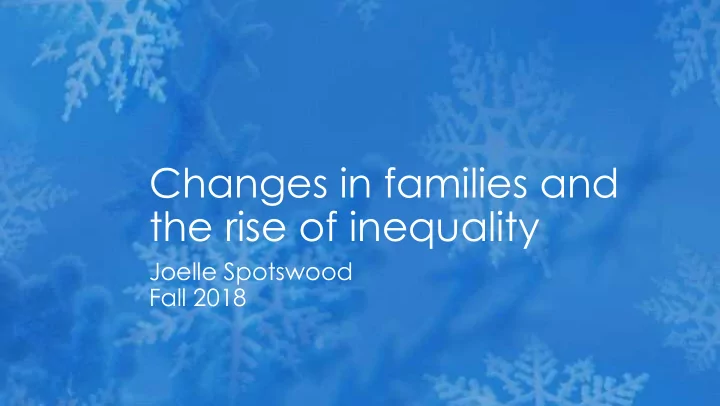

Changes in families and the rise of inequality Joelle Spotswood Fall 2018
The uneven spread of single-parent families: What do we know? Where do we look for answers? Ellwood, D.T., & Jencks, C. (2004). › Basically an extended and very extensive lit review for the increase in single-parent families › Economic and non-economic components, many are interrelated and repeated in various parts of the article – Education – Marriage, divorce and cohabitation – Childbirth patterns – Attitudes, beliefs, and norms – Wages and employment opportunities
Single parent families › Rise in single parent families, especially since the 1970s › Different by race: African American women more likely to be head of household › Single parent families more likely to be low- income › But we’ll let the charts speak for the data…
Percent of children not living with both biological parents (US and select European Nations
U.S. Mothers and habitation status: all and then by education
Single U.S. moms who have never married
Marital status of white and African American moms
Single moms by race and education
Married women by race and education
See packet (Figures 1.20-1.23) for median wage by gender, race, and education
Select determinants COHABITATION MARRIAGE, EDUCATION AND KIDS › Increase pre-marital sex › Tied to education › Non-marital birth increase › Educated waiting longer to marry and have kids › Weak ties, especially compared to European › Less educated having kids younger, waiting longer to get married
Select determinants NONECONOMIC › Increased access to birth control and legal abortions › Changes in attitudes towards sex and cohabitation › Changes in efficacy and control › Changes in no fault divorce
Economic determinants › Welfare – supportive rather than encouraging › Wages- – As we have read elsewhere (decrease in real wages, decrease in low-skill) › Women entering the labor force doesn’t offset the rise in single-parent households › No significant conclusion drawn as to the causes of the proliferation of single-parent families
Trends in children’s attainments and their determinants as family income inequality has increased Haveman, R., Sandefur, G., Wolfe, B., & Voyer, A. (2004) › Income gap: slower growth at bottom, more rapid at top › Examine parental capital: finical, social, and cultural. Usually related to parental education › 1980-2000 – 4% fewer African American kids living in a two-parent (married) household – 10% fewer Hispanic children were. – Data for white kids between 18985-2000: 4% fewer white children were living in a married two-parent household
Children’s attainment and outcomes › Teen pregnancy has decreased since 1990 – Hispanic highest, replacing African Americans › Increase in high school graduate for all races – African Americans increased by 9% – Hispanic by 7% – White by 4% › Race still matters, though. In 2000 – 92% of whites between 18-24 graduated high school – 84% and 64% of African Americans and Hispanics respectively – 35% of all whites have Bachelors, 20% African American, 18% Hispanic
Poverty Rates, reduction, mean income and Gini by race 1975-2000
Related children under 18 living below › See table 4.3 in the packet selected poverty levels by age, family structure, race and Hispanic origin, 1980- 2000
DISTRIBUTION OF 6-18 Y.O. ACCORDING TO PARENTS’ HIGHEST EDUCATION LEVEL BY CHILD’S RACE- ETHNICITY, 1974- 1999
Summary › Some importance variables regarding attainment have become more unequal, though other important measures, like class size, expenditures per student and an improvement in neighborhood poverty may offset these factors. › Significant gain in children’s outcome is increased parental education, but that also reproduced the inequality for the future › This will be exacerbated by the increasing speed by which the upper decile is pulling away from the working classes.
Inequality among American families with children, 1975 to 2005. Western, B., Percheski, C., & Bloome, D. (2008). › Between 1975-2005, income inequality in families that have kids increased by 2/3. › Rapid growth in the top economic percentiles increased inequality › What makes this study unique is the intersectional approach the authors take with labor markets and families being “two intersecting domains that shape the overall distribution of economic resources across families with children” (906).
Most contributory to income inequality › “changes in the mean and spread of group incomes” propelled the income inequality most (912). › families headed by college graduates fare much better than their counterparts › increase in high school and college graduates offsets some of the potential inequality › increased participation by women in the labor force even though single parent households have increased › within-group income variance contributes significantly to income inequality
More high school graduates, more college graduates, but more variance
Composite: Race still matters! › Single parent families increased since the 1970s › High school and college graduation rose › Declining rates of marriage, increased number of births out of wedlock › Unequal wage growth (and speed of that growth at the top) increases inequality › More women in the workforce, partially offsets increase in single parent families
Recommend
More recommend